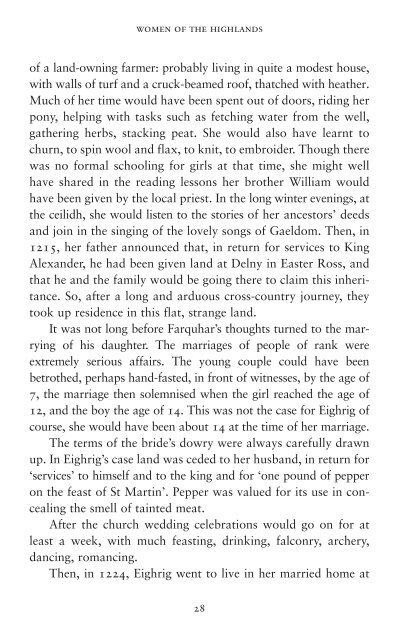Women of the Highlands by Katharine Stewart sampler
What was the crime of the last wich burnt in the Highlands? Which Jacobite lady led men to war while her Hanoverian husband stayed at home? Who were the first Highland women to be recorded in history? And how have wome's lives changed since medieval times? Katharine Stewart takes us to the heart of the Highlands in her history of the women who shaped this land and handed down the legends which have provided a rich vein of material for generations. From the women of the shielings to ladies at court, from bards to conservationists, authors to folk-singers, Women of the Highlands examines how the culture of the Highlands was created and passed down through the centuries, and how the tradition is continuing today.
What was the crime of the last wich burnt in the Highlands?
Which Jacobite lady led men to war while her Hanoverian husband stayed at home?
Who were the first Highland women to be recorded in history?
And how have wome's lives changed since medieval times?
Katharine Stewart takes us to the heart of the Highlands in her history of the women who shaped this land and handed down the legends which have provided a rich vein of material for generations. From the women of the shielings to ladies at court, from bards to conservationists, authors to folk-singers, Women of the Highlands examines how the culture of the Highlands was created and passed down through the centuries, and how the tradition is continuing today.
Create successful ePaper yourself
Turn your PDF publications into a flip-book with our unique Google optimized e-Paper software.
women <strong>of</strong> <strong>the</strong> highlands<br />
<strong>of</strong> a land-owning farmer: probably living in quite a modest house,<br />
with walls <strong>of</strong> turf and a cruck-beamed ro<strong>of</strong>, thatched with hea<strong>the</strong>r.<br />
Much <strong>of</strong> her time would have been spent out <strong>of</strong> doors, riding her<br />
pony, helping with tasks such as fetching water from <strong>the</strong> well,<br />
ga<strong>the</strong>ring herbs, stacking peat. She would also have learnt to<br />
churn, to spin wool and flax, to knit, to embroider. Though <strong>the</strong>re<br />
was no formal schooling for girls at that time, she might well<br />
have shared in <strong>the</strong> reading lessons her bro<strong>the</strong>r William would<br />
have been given <strong>by</strong> <strong>the</strong> local priest. In <strong>the</strong> long winter evenings, at<br />
<strong>the</strong> ceilidh, she would listen to <strong>the</strong> stories <strong>of</strong> her ancestors’ deeds<br />
and join in <strong>the</strong> singing <strong>of</strong> <strong>the</strong> lovely songs <strong>of</strong> Gaeldom. Then, in<br />
1215, her fa<strong>the</strong>r announced that, in return for services to King<br />
Alexander, he had been given land at Delny in Easter Ross, and<br />
that he and <strong>the</strong> family would be going <strong>the</strong>re to claim this inheritance.<br />
So, after a long and arduous cross-country journey, <strong>the</strong>y<br />
took up residence in this flat, strange land.<br />
It was not long before Farquhar’s thoughts turned to <strong>the</strong> marrying<br />
<strong>of</strong> his daughter. The marriages <strong>of</strong> people <strong>of</strong> rank were<br />
extremely serious affairs. The young couple could have been<br />
betro<strong>the</strong>d, perhaps hand-fasted, in front <strong>of</strong> witnesses, <strong>by</strong> <strong>the</strong> age <strong>of</strong><br />
7, <strong>the</strong> marriage <strong>the</strong>n solemnised when <strong>the</strong> girl reached <strong>the</strong> age <strong>of</strong><br />
12, and <strong>the</strong> boy <strong>the</strong> age <strong>of</strong> 14. This was not <strong>the</strong> case for Eighrig <strong>of</strong><br />
course, she would have been about 14 at <strong>the</strong> time <strong>of</strong> her marriage.<br />
The terms <strong>of</strong> <strong>the</strong> bride’s dowry were always carefully drawn<br />
up. In Eighrig’s case land was ceded to her husband, in return for<br />
‘services’ to himself and to <strong>the</strong> king and for ‘one pound <strong>of</strong> pepper<br />
on <strong>the</strong> feast <strong>of</strong> St Martin’. Pepper was valued for its use in concealing<br />
<strong>the</strong> smell <strong>of</strong> tainted meat.<br />
After <strong>the</strong> church wedding celebrations would go on for at<br />
least a week, with much feasting, drinking, falconry, archery,<br />
dancing, romancing.<br />
Then, in 1224, Eighrig went to live in her married home at<br />
28


















